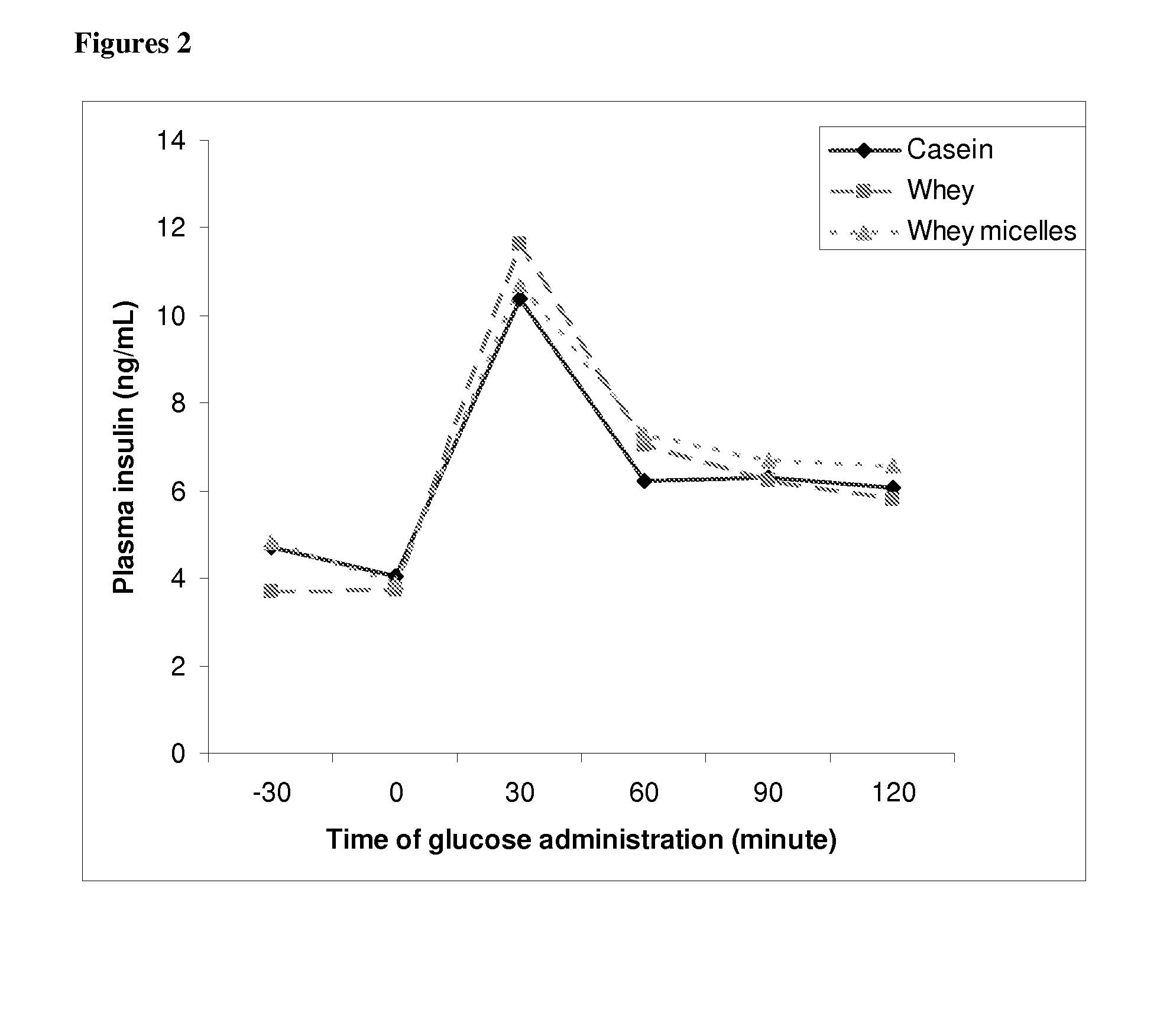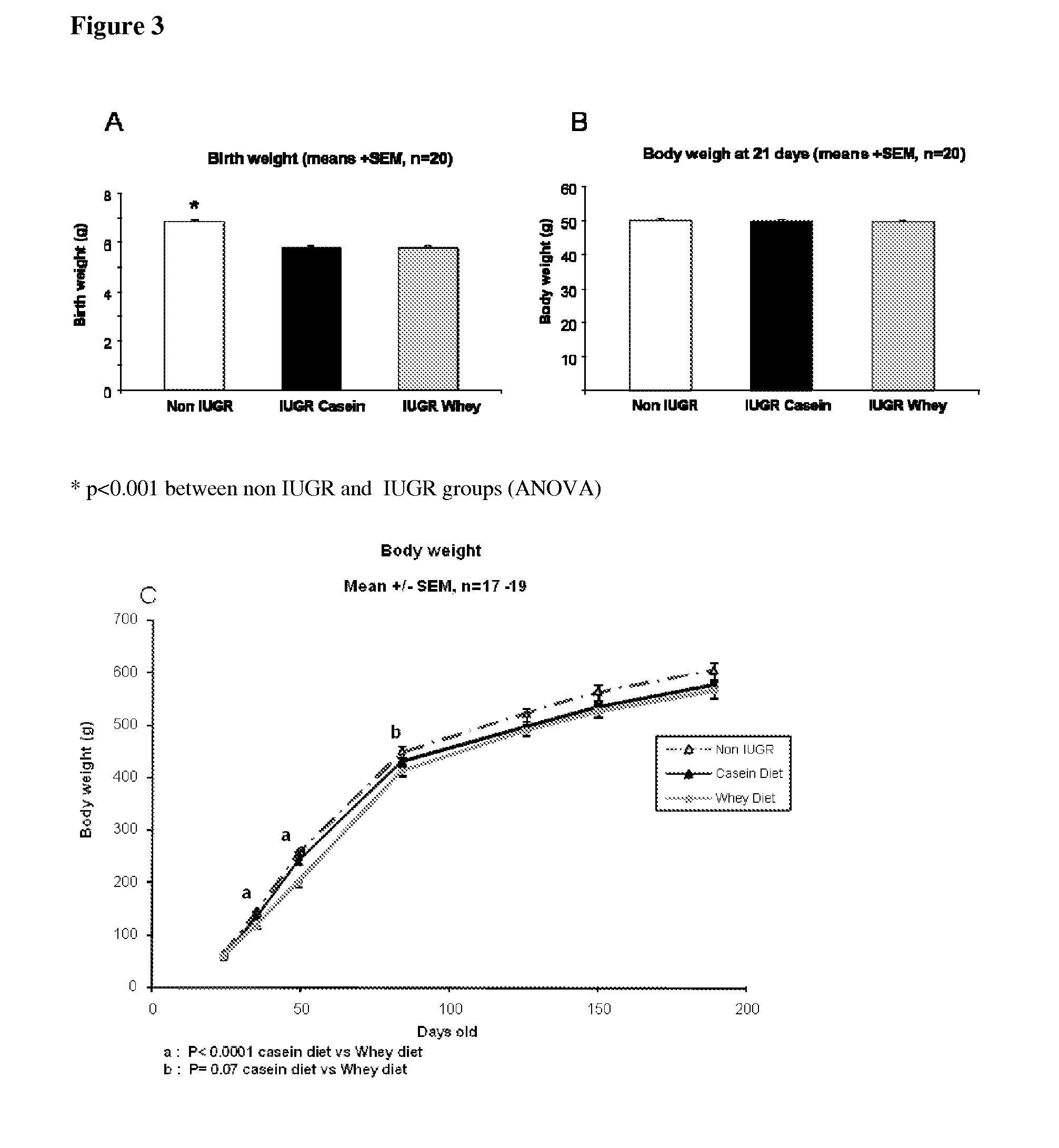Promotion of healthy catch-up growth
- Summary
- Abstract
- Description
- Claims
- Application Information
AI Technical Summary
Benefits of technology
Problems solved by technology
Method used
Image
Examples
example 1
[0048]An example of the composition of an infant formula for use according to the invention is given below:
per 100 kcalper litreNutrientEnergy (kcal)100630Protein (g)1.59.45(skimmed milk powder, modifiedsweet whey)free phenylalanine (mg)30189free isoleucine (mg)13.585free tryptophan (mg)4.930.9free histidine (mg)2.515.8casein:whey ratio40:6040:60Fat (g)5.333.4Linoleic acid (g)0.74.4α-Linolenic acid (mg)106668DHA (mg)11.572.5ARA (mg)11.572.5Linoleic acid: α-Linolenic acid6.56.5Lactose (g)11.673.1Minerals and ElectrolytesNa (mg)25158K (mg)89561Cl (mg)64403Ca (mg)64403P (mg)32202Ca / P2.02.0Mg (mg)6.943.5Mn (ng)8.050.4Vitamins and Trace ElementsVitamin A (IU)3502205Vitamin D (IU)60378Vitamin E (IU)1.27.6Vitamin K1 (μg)8.050.4Vitamin C (mg)1063Vitamin B1 (mg)0.070.44Vitamin B2 (mg)0.150.95Niacin (mg)1.06.3Vitamin B6 (mg)0.0750.47Folic acid (μg)1275.6Pantomenic acid (mg)0.452.83Vitamin B12 (μg)0.31.89Biotin (μg)2.213.9Choline (mg)1063Inositol (mg)5.031.5Taurine (mg)7.044.1Carnitine (mg)1.6...
example 2
[0050]This example investigates the effect of protein type on body composition and insulin sensitivity using a rat model of semistarvation-refeeding.
[0051]Animals and Diets
[0052]All rats were obtained from Elevage Janvier (France), caged singly in a temperature-controlled room (22±1° C.) with a 12-h light / dark cycle, and maintained on a commercial chow diet (Kliba, Cossonay, Switzerland) consisting, by energy, of 24% protein, 66% carbohydrates, and 10% fat, and had free access to tap water. 6 wk old male Sprague-Dawley rats were divided into 3 groups (n=6-8) of similar mean body weight and food-restricted for a period of 2 weeks, during which they received daily a fixed-ration of chow corresponding to about 50% of their spontaneous ad libitum daily food intake. After this semistarvation phase, during which growth was essentially arrested, the animals were re-fed for 2 weeks on the test-diets shown in Table 1 below. Each group of rats received a diet with a different protein componen...
example 3
[0060]This example investigates the effect of protein type on growth and glucose tolerance and later basal glycaemia, and insulinaemia and insulin sensitivity (assessed by ratio of basal glucose to insulin) in a rat model of intrauterine growth restriction.
[0061]Animals and Diets
[0062]27 gestating rats and 6 virgin rats were purchased from Charles River (France) After arrival, the animals were caged individually in a room at 25° C. with 55% relative humidity and a 12 h light / dark cycle and had free access to water and a commercial chow rat diet (Kliba 3434; Provimi, CH-4303 Kaiseraugst, Switzerland). At day 10 of gestation the gestating animals were divided randomly into two groups with similar body weight. One group continued to have free access to food (non IUGR group, n=7)) and the other group was exposed to IUGR by 50% food restriction (relative to non-pregnant rats) from day 11 gestation until birth (IUGR group, n=20)
[0063]After birth, the body weight of pups was recorded with...
PUM
| Property | Measurement | Unit |
|---|---|---|
| Fraction | aaaaa | aaaaa |
| Fraction | aaaaa | aaaaa |
| Fraction | aaaaa | aaaaa |
Abstract
Description
Claims
Application Information
 Login to View More
Login to View More - R&D
- Intellectual Property
- Life Sciences
- Materials
- Tech Scout
- Unparalleled Data Quality
- Higher Quality Content
- 60% Fewer Hallucinations
Browse by: Latest US Patents, China's latest patents, Technical Efficacy Thesaurus, Application Domain, Technology Topic, Popular Technical Reports.
© 2025 PatSnap. All rights reserved.Legal|Privacy policy|Modern Slavery Act Transparency Statement|Sitemap|About US| Contact US: help@patsnap.com



